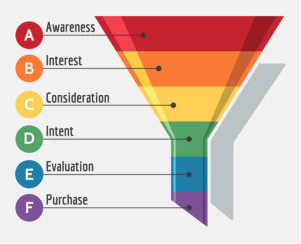Want more leads? Try sales and marketing alignment
To be successful in business, you must understand the buyers’ journey—that is, the steps a potential customer takes from awareness of your product or service through to eventual purchase. Typically, the marketing team is responsible for generating leads and the sales team for turning these leads into clients. Using this model, the teams work on separate tasks at different times. Key to this, though, is that the sales and marketing teams collaborate. Take a look at how these two departments should work together to ensure on-going success.
The marketing-sales funnel

The easiest way to map your buyer’s journey is by plotting it along the marketing-and-sales funnel. If you follow our blog you’ll know this funnel is fundamental to B2B marketing. Each step to eventual purchase is represented as a layer of the funnel. Generally speaking, marketing is responsible for the early steps—the lead generation and nurturing—and sales takes the lead role in converting the lead to a deal. Let’s look at the six steps in the funnel and how alignment between departments tends to happen during each.
Awareness: How to raise awareness of your business
Marketers use advertising, PR campaigns, social media and other tactics to make people aware of the company and its products/services, and once aware, keep it top of mind.
Alignment is collaborating on the buyer targeting for the campaigns, and keeping the sales team informed of the campaign activity. For small and mid-sized B2Bs this can happen during a standing monthly meeting.
Interest: How to nurture relationship so that people might buy from you in future
Leads that show interest need good information to learn more. It’s the marketers’ job to provide this, and typically it happens through a nurture process. This is where a drip (aka automated) campaign can be very useful. At this stage, marketing is developing a relationship with the potential buyer.
Alignment at this stage is working with the sales team (or at least informing them about) the development of educational content and the touch points, including lead capture (getting someone’s name and email so you can stay in touch).
Consideration: How to interact with potential buyers as they research the best solution
The potential buyer is actively considering making a purchase. At this stage, the lead is usually thought of as a sales-qualified lead and the sales team takes on the responsibility of nurturing the relationship.
Alignment is ensuring a smooth hand-off and marketing supporting the sales team with ongoing touch points, events or collateral.
Intent: What marketing and sales can do when it’s clear a purchase is imminent
Marketing and sales are looking for signs that a purchase may happen. The buyer is still conducting research, so providing content is key here, as is communicating reasons to buy from you.
Alignment is typically communication about the content being provided, ensuring both departments are using the same key messages about the company and product/service strength.
Evaluation: How to help close the deal when buyers are down to the final decision
The potential buyer evaluates the product, price, and offer. This is the final stage before making a purchase and there could be a few decision makers reviewing the information.
Now the sales team is likely taking the lead, but alignment ensures both teams use the same messaging, collaborate on content and collateral, and everyone knows what touch points are happening when (should marketing send that person a mass email, or leave them to personal touchpoints by a sales person, for example).
Purchase: What communication needs to happen when the deal is closed
The result—a sale! The sales team gets the customer across the line, but marketing may be supporting with a welcome package or other new customer information.
The teams align by communicating anticipated and recent deals, and continued joint communication to that person.
Steps toward alignment
When marketing and sales are aligned, the conversion happens more easily because both departments are making a joint effort, and sales can have more meaningful, impactful conversations because they are equipped with better information and tools. Also, there is more transparency surrounding lead and deal tracking so the team is able to be more effective in the future.
Getting your sales and marketing departments aligned requires its own strategy. Consider these best practices.
1. Create top-down involvement
It’s crucial that your alignment goals come from the teams themselves, and possibly with some of the executive team. It may also be worthwhile to hire an intermediary to bridge the two departments.
2. Foster collaboration and document processes
Traditionally kept separate, your sales and marketing departments need to learn to work in an open, transparent, and collaborative environment. Document your hand-off process from marketing to sales. Anticipate sending leads back up the funnel to marketing and document the process.
3. Define leads and focus on quality
It might seem obvious but both departments need to be on the same page. Go back to basics. Standardize jargon. What exactly is a lead? A market qualified lead? A sales-qualified lead? Some see sales as a numbers game, more concerned with quantity over quality leads. But when departments are aligned, marketing can hand off leads to sales along with a deep profile about their needs that helps get the purchase result.
4. Rethink ROI
Once the funnel numbers are being tracked the teams can improve the rates of conversion from stage to stage. It’s a great starting point to tracking marketing effectiveness, which we find most companies we work with haven’t ever tracked.
5. Use a CRM and leverage dashboard reporting
A busy sales and marketing team will have numerous projects moving up and down the marketing funnel at any given time. Consider using a CRM to track projects, and build a dashboard for real-time reporting. This will give you access to data about what’s working and what isn’t.
Although their work is inextricably linked, marketing and sales teams often work in silos. This is an outdated structure. And it’s a mistake because it’s better for your buyers—and your business—to have an allied, collaborative marketing and sales team. Luckily, it’s not that difficult to make the shift. At Hop Skip Marketing we do this for many of our clients and it is typically up and running well within six months. With a few tweaks, you can streamline your internal processes and be on your way to lasting marketing and sales success.


